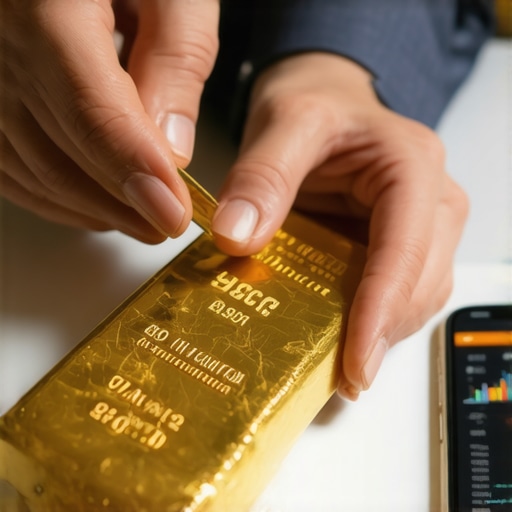Introduction to Investing in Gold
Investing in gold has long been regarded as a reliable way to secure wealth, especially during times of economic uncertainty. For beginners, understanding the fundamental do’s and don’ts of gold investment is crucial to achieving financial success. Whether you aim to diversify your portfolio or hedge against inflation, the right approach can make a significant difference. This article will guide you through the essential practices to enhance your gold investment journey.
Understanding Gold as an Investment
Gold is not merely a shiny metal; it has intrinsic value stemming from its rarity and desirability. When investing in gold, it’s important to recognize the various forms it can take, including physical gold, gold ETFs, and gold mining stocks. Each type has its advantages and disadvantages, which budding investors must consider before making a decision. For instance, physical gold can provide a tangible asset, while ETFs offer liquidity and ease of trading.
Do Your Research
Before diving into the gold market, conduct thorough research. Understanding market trends and historical prices can help you make informed decisions. Furthermore, familiarizing yourself with the 2025 gold price forecast can provide valuable insights into potential future movements. Keep an eye on global economic indicators, as these can significantly impact gold prices.
Don’t Rush Your Decisions
Investing in gold should not be a rushed endeavor. Take your time to assess your investment goals and risk tolerance. The gold market can be volatile, and making impulsive decisions can lead to unnecessary losses. Patience is key; waiting for the right moment to purchase can yield better returns.
Choosing the Right Type of Gold Investment
As mentioned previously, gold investments vary widely. Beginners should evaluate what aligns best with their goals. For example, understanding different types of gold investments is essential to making wise choices. Each investment type has unique characteristics and risks, so consider what fits your investment strategy.
Do Diversify Your Portfolio
Just like any other investment, diversification is crucial. Avoid overexposure to gold alone by spreading your investments across various asset classes. This reduces risk and increases overall returns. Consider complementing your gold investments with stocks, bonds, and real estate, as this can create a more balanced portfolio.
Don’t Ignore Storage and Security
When investing in physical gold, storage and security become paramount. Make sure to assess how and where you will store your gold. Whether you choose a safe deposit box or secure home storage, ensuring the safety of your investment is critical. Consider the costs associated with storage and whether they fit into your investment strategy.
Conclusion
Investing in gold can be a rewarding venture for beginners, provided you adhere to these essential do’s and don’ts. By conducting thorough research, making informed decisions, and understanding the various forms of gold investments, you can build a strong foundation for your investment journey. Always keep your long-term goals in mind, and navigate the gold market with confidence.
Understanding Gold Market Dynamics
The gold market is influenced by a multitude of factors, including supply and demand, geopolitical events, and economic indicators. Investors must grasp these dynamics to make educated decisions. Monitoring gold market analysis can provide a clearer picture of current trends and future projections, assisting investors in timing their purchases effectively.
Do Stay Updated with Market Trends
Regularly following market updates and news reports is essential for staying informed. Websites, newsletters, and market analysis reports can provide insights into price fluctuations and emerging trends. For instance, the 2025 gold price trends can help you anticipate market movements and adjust your investment strategy accordingly.
Don’t Overlook Global Events
Global events can significantly impact the gold market. Political instability, economic downturns, or changes in monetary policy can lead to price volatility. Being aware of these events allows investors to react promptly. For instance, central banks’ gold purchases can signal shifts in the market, which is essential to understand when planning your investments.
Evaluating Gold Investment Options
When considering gold investments, it’s vital to evaluate each option’s pros and cons. Different forms of gold, such as bullion, coins, and ETFs, cater to various investment strategies and risk tolerances. For example, understanding the varied types of gold investments enables investors to make well-informed decisions that align with their financial goals.
Do Consider Gold ETFs for Liquidity
Gold Exchange-Traded Funds (ETFs) offer an excellent way to invest in gold without the need for physical storage. They provide liquidity and can be traded like stocks. Investors looking for a straightforward approach to gold investment may find ETFs a suitable option. Furthermore, choosing the right path between gold ETFs and mutual funds can maximize investment returns while minimizing risks.
Don’t Forget About Fees and Expenses
Investing in gold, whether physical or in the form of ETFs, often comes with associated fees. Understanding these costs is crucial for calculating your potential returns. Transaction fees, storage costs, and management fees can eat into your profits. Therefore, always evaluate the total cost of ownership when considering different gold investment avenues.
Long-Term vs. Short-Term Gold Investment Strategies
Deciding between a long-term or short-term investment strategy in gold depends on your financial objectives. Long-term investors may benefit from holding gold during economic downturns, while short-term traders might take advantage of price fluctuations. Understanding your investment horizon will shape your strategy and approach.
Do Set Clear Investment Goals
Whether you are investing for retirement, wealth preservation, or speculation, having clear goals is essential. Setting specific, measurable, achievable, relevant, and time-bound (SMART) goals can guide your investment strategy effectively. Invest in best practices for gold investment strategies to align your approach with your financial objectives.
Don’t Ignore the Importance of Timing
Timing can play a critical role in gold investments. Purchasing gold during a market dip can lead to substantial long-term gains. Keeping an eye on price trends and employing technical analysis can enhance your timing strategies. Utilize resources such as gold price forecasts to make informed timing decisions.
Understanding Risk Management in Gold Investments
Risk management is a crucial aspect of any investment strategy, especially in the volatile gold market. Investors should assess their risk tolerance before committing to gold investments. Utilizing strategies such as diversification can mitigate risks and enhance overall portfolio stability. For instance, combining different types of gold investments can create a balanced approach, reducing exposure to market fluctuations.
Do Use Stop-Loss Orders
Implementing stop-loss orders is a practical way to manage risk when trading gold. This tool automatically sells your investment if it falls below a predetermined price, limiting potential losses. Such proactive measures can safeguard your investment against sudden market downturns, making them a vital part of your trading strategy.
Don’t Overleverage Your Position
While leverage can amplify returns, it also increases the risk of significant losses. Overleveraging can lead to margin calls, forcing investors to sell at unfavorable prices. It is essential to understand the implications of using leverage in your gold trading strategy and to maintain a conservative approach.
Exploring Gold Trading Techniques for Profit Maximization
Adopting effective trading techniques can significantly enhance your gold investment returns. Various strategies, such as day trading, swing trading, and long-term investing, cater to different investor profiles and market conditions. Understanding these techniques and their suitability for your investment style is essential.
Do Stay Informed About Technical Analysis
Technical analysis involves studying price patterns and market trends to predict future movements. Familiarizing yourself with this method can assist in making educated trading decisions. Resources like essential gold trading techniques can offer valuable insights into how to apply technical analysis effectively.
Don’t Disregard Fundamental Analysis
While technical analysis focuses on price movements, fundamental analysis examines the underlying factors affecting gold prices. Macroeconomic indicators, interest rates, and geopolitical developments can influence gold’s value. A well-rounded approach that incorporates both technical and fundamental analysis will position you for success in the gold market.
Investing in Physical Gold: A Tangible Asset Approach
Physical gold remains a popular choice among investors seeking a tangible asset. Options such as gold bars and coins not only provide intrinsic value but also serve as a hedge against inflation and economic uncertainty. Understanding the nuances of investing in physical gold can lead to better investment choices.
Do Research Reputable Dealers
When purchasing physical gold, it is vital to buy from reputable dealers. Researching and verifying the dealer’s credentials can prevent fraudulent transactions. Websites that provide guidance on finding reliable gold dealers can be particularly helpful for new investors.
Don’t Neglect Storage and Security Considerations
Investing in physical gold requires careful consideration of storage and security. Investors must evaluate whether to store their gold at home, in a safe deposit box, or through a professional storage service. Each option has its own risks and benefits, and understanding these can protect your investment over time.
Anticipating Future Trends in Gold Investments
As the gold market evolves, staying ahead of trends is essential for informed investment decisions. Future trends may be influenced by factors such as economic conditions, technological advancements, and shifts in consumer preferences. Keeping abreast of these developments can provide valuable insights for strategic planning.
Do Follow Expert Insights and Predictions
Consulting expert analyses and forecasts is crucial in navigating the gold market. Resources like 2025 gold price forecasts can help you anticipate market movements and adjust your investment strategy accordingly.
Don’t Ignore Emerging Investment Vehicles
New investment vehicles, such as gold-backed cryptocurrencies and digital gold platforms, are gaining traction. Exploring these options may offer additional avenues for diversification and growth. Understanding the pros and cons of these innovative investments can enhance your overall portfolio strategy.
Understanding Gold Market Dynamics
The gold market is influenced by a myriad of factors, from global economic conditions to investor sentiment. Understanding these dynamics is essential for making informed investment decisions. Key variables such as inflation rates, currency strength, and geopolitical tensions can significantly impact gold prices. Keeping an eye on these indicators will help you anticipate market trends and adjust your investment strategies accordingly.
Do Monitor Macroeconomic Indicators
Macroeconomic indicators like gross domestic product (GDP) growth, unemployment rates, and inflation can provide insight into the health of the economy and subsequently influence gold prices. Resources that analyze expert predictions on these economic factors can offer valuable information for investors looking to time their purchases effectively.
Don’t Overlook Geopolitical Events
Geopolitical events, such as conflicts, elections, and policy changes, can lead to increased volatility in the gold market. Investors should remain vigilant and informed about current events that could impact gold prices. For instance, tensions in key regions can drive investors towards gold as a safe haven, thus affecting demand and pricing.
Evaluating Gold Investment Options
When investing in gold, it’s vital to understand the various options available, from physical gold to gold ETFs and mining stocks. Each type of investment comes with its own risk profile and potential returns. Evaluating these options will help you align your investment choices with your financial goals.
Do Consider Gold ETFs for Diversification
Gold Exchange-Traded Funds (ETFs) are a popular choice for investors seeking exposure to gold without the challenges of storing physical assets. They provide liquidity and diversification, making them an attractive option for both new and seasoned investors. Understanding how to effectively choose between gold ETFs and mutual funds can enhance your investment strategy.
Don’t Forget About Gold Mining Stocks
Investing in gold mining stocks can offer leveraged exposure to gold prices. As gold prices rise, mining companies often experience increased profitability, leading to potentially higher stock prices. However, these investments carry additional risks related to operational performance and management decisions, so it’s important to conduct thorough research before investing.
Mastering the Art of Timing Your Investments
Timing can be a crucial element in gold investing. Understanding when to buy or sell can greatly affect your investment returns. Utilizing various tools and strategies can help you make informed decisions about your gold investments.
Do Utilize Dollar-Cost Averaging
Dollar-cost averaging is an investment strategy that involves regularly investing a fixed amount of money into gold over time. This method can mitigate the effects of market volatility by spreading out your purchases, allowing you to buy more gold when prices are low and less when prices are high. This disciplined approach can enhance your overall returns in the long run.
Don’t Rush into Decisions
Emotional trading can lead to poor decisions in the gold market. It’s essential to avoid making impulsive choices based on short-term price movements or market hype. Taking the time to analyze your investment strategy and making decisions based on thorough research can lead to more favorable outcomes.
Frequently Asked Questions About Gold Investing
What are the benefits of investing in gold?
Investing in gold offers numerous benefits, including acting as a hedge against inflation, providing portfolio diversification, and serving as a safe haven during economic uncertainty. Gold’s intrinsic value often remains stable, making it a reliable asset choice for investors.
How can I invest in gold?
You can invest in gold through various methods, including purchasing physical gold (coins, bars), buying gold ETFs, investing in gold mining stocks, or trading gold futures. Each option has its own risk and return profile, so it’s essential to choose according to your investment goals.
Is gold a good investment in times of economic downturn?
Yes, gold is often considered a good investment during economic downturns because it tends to retain its value when other assets, like stocks, may decline. Investors flock to gold as a safe haven, which can drive up prices during turbulent times.
How does gold price fluctuate?
Gold prices fluctuate based on various factors, including supply and demand dynamics, currency strength, interest rates, and geopolitical events. Keeping an eye on these influences can help investors anticipate price movements.
What is the best time to buy gold?
The best time to buy gold can depend on market conditions and personal financial situations. Many investors suggest buying during dips in the market or utilizing dollar-cost averaging to mitigate volatility. Monitoring macroeconomic indicators can also provide insight into optimal buying times.
Are there risks associated with investing in gold?
While gold is often viewed as a stable investment, there are risks involved, including market volatility, storage costs for physical gold, and potential underperformance compared to other asset classes. It’s vital to conduct thorough research before investing.
How do gold ETFs work?
Gold ETFs (Exchange-Traded Funds) are investment funds that track the price of gold. They allow investors to gain exposure to gold without the need to own physical gold. Gold ETFs trade like stocks on exchanges, providing liquidity and ease of access.
Can I invest in gold with a retirement account?
Yes, you can invest in gold through a retirement account, such as a Self-Directed IRA or a Roth IRA. These accounts allow you to allocate a portion of your retirement savings to physical gold or gold-related investments.
What are gold mining stocks?
Gold mining stocks represent shares in companies that mine and produce gold. Investing in these stocks can provide leveraged exposure to gold prices, as the profitability of mining companies often increases when gold prices rise.
How much of my portfolio should I allocate to gold?
The ideal allocation to gold varies based on individual risk tolerance, investment goals, and market conditions. Many financial advisors recommend allocating 5-10% of your portfolio to gold to achieve diversification while balancing risk.
Authority Resources for Gold Investing
To deepen your understanding of gold investing and stay informed, consider utilizing the following trusted resources:
- Kitco News – A leading source for precious metals market news and analysis.
- World Gold Council – Provides comprehensive information on gold market trends and investment strategies.
- Investing.com – Offers market analyses, charts, and gold price forecasts.
- Bloomberg – A reliable source for financial news, including commodities and gold market updates.
- Forbes – Features articles on gold investing trends and expert insights.
Conclusion: Embracing Gold as a Valuable Investment
Investing in gold can be a rewarding strategy when approached thoughtfully. By understanding the market dynamics, evaluating different investment options, and mastering the art of timing your investments, you can enhance your chances of success in the gold market. Utilize the insights from this guide, the FAQ section, and the authority resources to navigate your gold investment journey effectively. Remember, gold remains a timeless asset that can serve as a hedge against inflation and economic uncertainty, making it a valuable addition to your investment portfolio.











Reading this detailed guide on gold investing really highlights how important it is for beginners to approach this asset thoughtfully. I especially resonate with the point about not rushing decisions—I’ve observed that gold prices can be quite volatile in the short term, so patience and timing are essential. Diversification also stood out to me; while gold is a valuable hedge against inflation, depending entirely on it feels risky without adding other asset types to a portfolio. Personally, I started investing in gold ETFs to avoid physical storage hassles and fees, but I sometimes wonder if holding tangible gold adds a psychological comfort that’s worth the additional costs. I’m curious how others balance between physical gold and ETFs? And for those who keep physical gold, how do you handle storage security in a way that feels both safe and cost-effective? It would be great to hear different strategies on managing these practical aspects, especially for newcomers trying to build confidence while safeguarding their investments.
Kara, you raised some great points about balancing physical gold and ETFs. From my experience, the choice really depends on your investment goals and tolerance for hassle versus liquidity. Physical gold indeed provides a tangible sense of security, especially during heightened economic uncertainty. However, storage and security are significant considerations. Personally, I opted for a high-quality safe deposit box at a local bank, which offers a good balance between safety and cost-effectiveness. It’s more secure than home storage but avoids the premium fees that come with professional vaulting services.
On the other hand, gold ETFs afford much easier liquidity and eliminate concerns over storage, making them more suitable for those who prefer convenience and quicker portfolio adjustments. But as the post highlights, these come with management fees that can eat into returns over time, and ETFs can be subject to market risks not tied solely to the physical gold price.
I wonder how others here prioritize these factors? Do you value the psychological comfort of physical gold despite the added responsibilities, or do you lean toward the streamlined nature of ETFs? Also, for those who store physical gold at home, what security measures have you found most effective without breaking the bank? Sharing these practical tips could really help newcomers navigate these challenges.